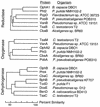Novel organization of the genes for phthalate degradation from Burkholderia cepacia DBO1
- PMID: 9851995
- PMCID: PMC107754
- DOI: 10.1128/JB.180.24.6529-6537.1998
Novel organization of the genes for phthalate degradation from Burkholderia cepacia DBO1
Abstract
Burkholderia cepacia DBO1 is able to utilize phthalate as the sole source of carbon and energy for growth. Two overlapping cosmid clones containing the genes for phthalate degradation were isolated from this strain. Subcloning and activity analysis localized the genes for phthalate degradation to two separate regions on the cosmid clones. Analysis of the nucleotide sequence of these two regions showed that the genes for phthalate degradation are arranged in at least three transcriptional units. The gene for phthalate dioxygenase reductase (ophA1) is present by itself, while the genes for an inactive transporter (ophD) and 4,5-dihydroxyphthalate decarboxylase (ophC) are linked and the genes for phthalate dioxygenase oxygenase (ophA2) and cis-phthalate dihydrodiol dehydrogenase (ophB) are linked. ophA1 and ophDC are adjacent to each other but are transcribed in opposite directions, while ophA2B is located 4 kb away. The genes for the oxygenase and reductase components of phthalate dioxygenase are located approximately 7 kb away from each other. The gene for the putative phthalate permease contains a frameshift mutation in contrast to genes for other permeases. Strains deleted for ophD are able to transport phthalate into the cell at rates equivalent to that of the wild-type organism, showing that this gene is not required for growth on phthalate.
Figures







References
-
- Aftring R P, Taylor B F. Aerobic and anaerobic catabolism of phthalic acid by a nitrate respiring bacteria. Arch Microbiol. 1981;130:101–104.
-
- Amann E, Ochs B, Abel K J. Tightly regulated tac promoter vectors useful for the expression of unfused and fused proteins in Escherichia coli. Gene. 1988;69:301–315. - PubMed
-
- Assinder S J, Williams P A. The TOL plasmids: determinants of the catabolism of toluene and the xylenes. Adv Microb Physiol. 1990;31:1–69. - PubMed
Publication types
MeSH terms
Substances
Associated data
- Actions
LinkOut - more resources
Full Text Sources

